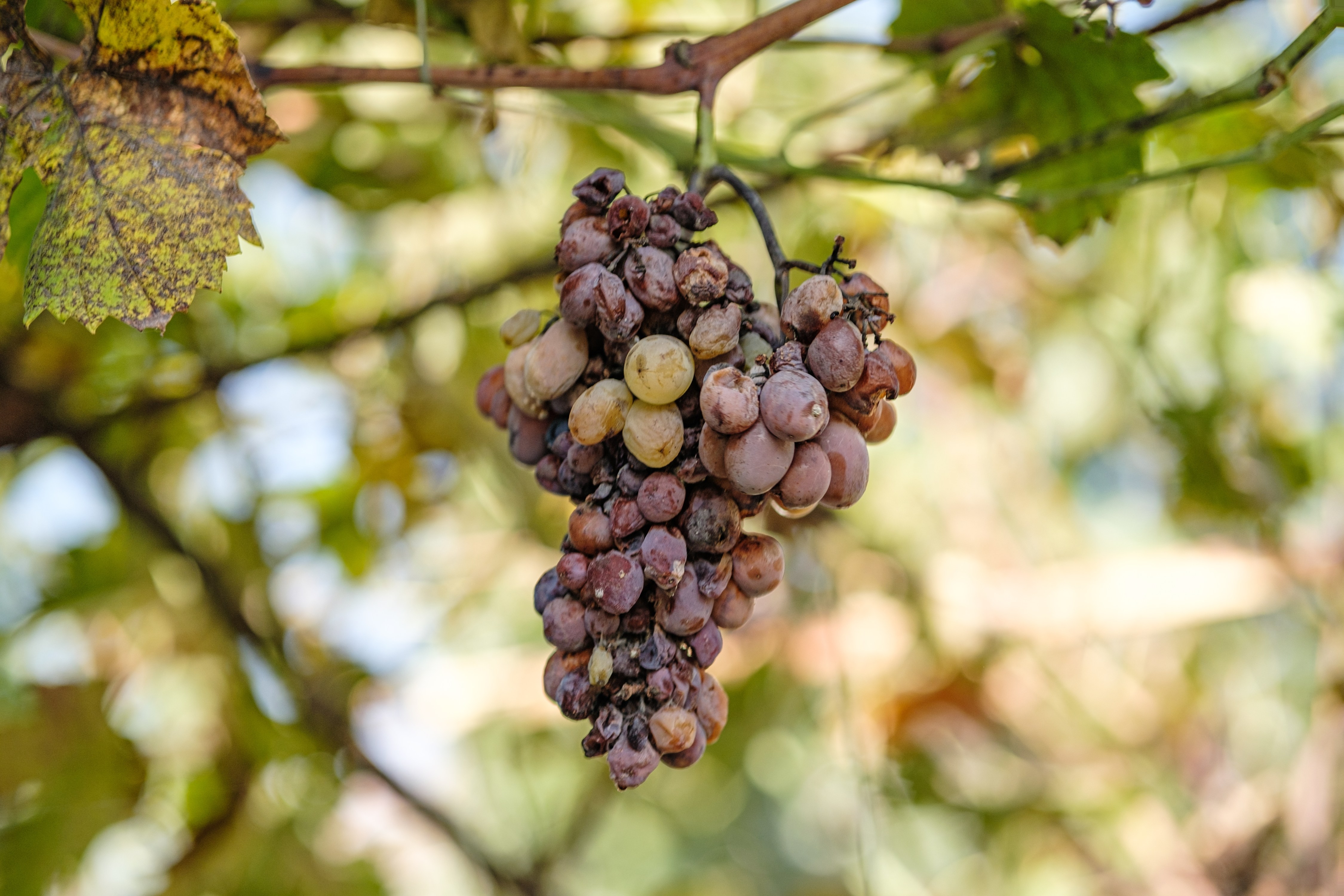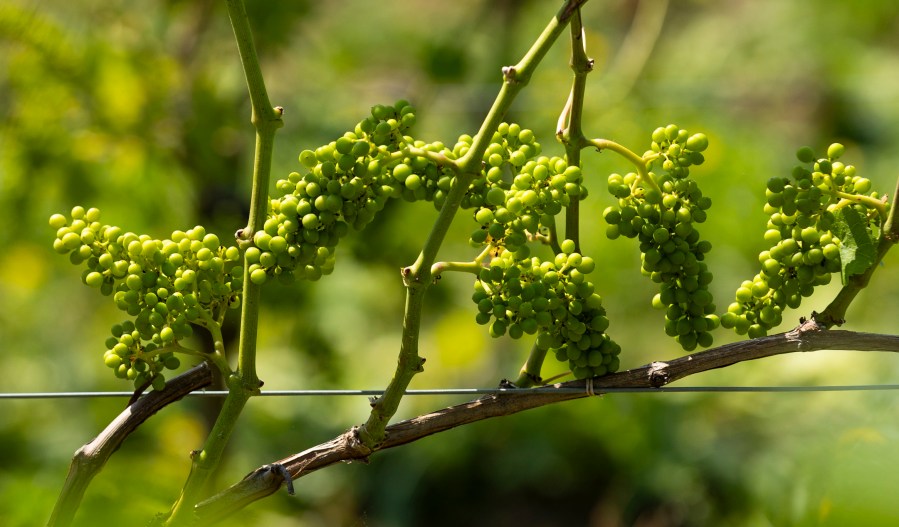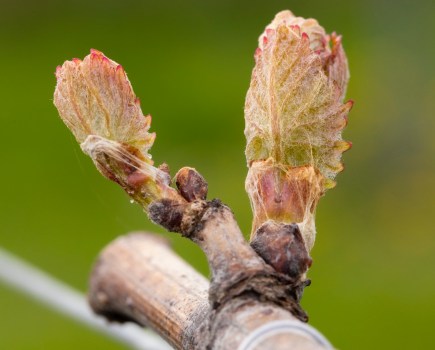Grapes are at the heart of what we do and understanding them is at the heart of good wine-making. Vineyard magazine gets back to basics with an up close and personal look at the grape bunch this month.
Do you know your peduncle from your pedicel?
First, let us consider the anatomy of the grape cluster. The bunch is attached to the vine shoot by the peduncle. The length of the main stem below this, after it begins to branch off, is the rachis. Where prominent laterals come off the rachis stem at the top, the cluster may be described as shouldered. If the first lateral is large and creates its own cluster, the bunch is winged.
Extending off from the rachis’ laterals are the pedicels or cap stems. These are where the individual flowers, and later the fruit, are attached to the cluster. The framework of the rachis can typically account for somewhere between 2% and 8% of the final weight of the grape bunch when it is ready for harvest.
Most cultivated grape varieties have flowers which contain both female and male parts, so they are capable of self-pollination. Each flower growing on a pedicel can be pollinated and can produce an individual grape.
The ovules are only briefly receptive after bloom. In areas with the highest temperatures fertilisation occurs within 12 hours. In UK temperatures it is likely to take around 48 hours. When the temperature is too low, the pollen tube may grow so slowly that fertilisation does not occur at all.
The pollinated flowers become grapes quickly. They are arranged on the rachis with relatively large gaps between them which will be closed as the grapes grow and swell.
The overall cluster can vary in shape and size, depending on the variety of grapevine. They might be conical, sometimes with prominent shoulders, cylindrical, sometimes also winged or form a double cluster of roughly equal sizes.
Training robotic harvesting machines
Researchers working on intelligent harvesting techniques have found that the grape cluster provides a unique complication for the machine vision-based information perception technology upon which most methodologies rely. The inherent diversity and randomness of each bunch makes it difficult to “teach” the machine vision system to accurately identify them.
This non-standard nature comes from a number of factors. Peduncles may be obscured by leaves, or the fruit may be entangled within the peduncle and vine (as anyone who has hand harvested will know well!) There is also a difficulty when the target of a robotic harvester – the peduncle as the optimal picking point – happens to be a very similar colour to all of the plant material which surrounds it.
At the moment, research is trialling deep learning models that segment grape cluster peduncles visually from the surrounding environment. This still remains a significant challenge, as on average the peduncles are likely to represent less than 2% of any given image that the robotic harvester analyses. We will continue to monitor developments in this area as they happen.
Problems with fruit set and uneven ripening
There are two key stages in the development of a bunch of grapes. First comes the growth phase – the development of the cluster structure, flowering and fruit set. That is followed up by maturation of the berries.
Fruit set is a complex process. It can be quantitatively measured as the proportion of flowers that turn into grapes. On average, it might be expected to see a fruit set of between 30% and 50%, however this can vary from variety to variety.
For the process to happen smoothly, the vines look for a high light intensity, good temperature and access to the requisite nutrients and water. When those elements are not in balance, the fruit may not set well, leading to a range of issues. Ultimately, this process can be viewed as the plant self-regulating the crop. If it is not in good health, with access to all of the required inputs, the fruit will not set well to avoid additional strain on the plant.
Poor weather during flowering can lead to a number of issues with fruitset. When temperatures are particularly low, the flowers are less likely to open. A slew of rain during the short flowering window can also hamper pollination. This can result in an uneven fruit set and different sized berries that ripen at different times.
Millerandage, sometimes called ‘hen and chicken’, is one outcome of these weather-related problems during flowering. The vine produces normal berries with seeds in the same bunch as smaller berries with no seeds – those described as the chicken grapes. Grape seeds produce hormones that stimulate the berry to grow. Berries with the most seeds will be larger than those with none at all.
All of these grapes are able to ripen normally, but the smaller berries will ripen much later. The yield is impacted because it is difficult to achieve uniform ripeness across the clusters.
Coulure is another condition that leads to poor fruit set. It is also referred to as ‘shatter’. Here the bunch excessively drops ovaries and young berries, resulting in fewer berries per bunch being left to mature.
There is little that can be done to avoid these problems, since they mainly arise in response to the weather during the flowering period. To minimise their impact, it may be necessary to harvest selectively, making multiple passes to ensure that only fully ripened grapes are picked. While this is an admittedly labour intensive approach, it does ensure that only the best quality fruit is harvested.
Uneven ripening across the bunch may also be down to an imbalance of nutrients or water stress, particularly during the crucial time of flowering and fruit set. This issue can be exacerbated in areas with sandy soils, because of the inherently poor nutrient and water retention capacity of the soil.
The vine may also have entered the dormant season with low amounts of stored carbohydrate. This is likely to impact floral development in the following spring. A heavy crop the previous season, disease reducing leaf area or an early leaf loss in cooler autumns can all contribute to lower levels of starch being held in reserve by the plant.
These factors are generally outside of the growers’ control, however canopy management can also play a role in giving each bunch the optimal chance of ripening evenly across the row. A thick canopy of leaves may create a microclimate that shields some berries from sunlight and airflow. Those grapes would have a delayed development compared to those that are more exposed. Pruning and leaf removal is the critical fix for giving each bunch access to adequate light and air.
Grape bunch compactness
The density of the grapes within a bunch is known as bunch compactness. The more compact a cluster is, the more susceptible the berries are to pests and diseases like Botrytis. A dense cluster may also be more likely to experience uneven ripening which can impact on yield and wine quality.
The inner part of a compact bunch is exposed to a higher concentration of water vapour and those grapes can have wet surfaces for extended periods, which provides an ideal environment for mould development. The close berry-to-berry contact can then allow disease and mould to spread quickly across the entire bunch.
This problem can be increased by the retention of debris from the flowering process within the bunch, like unfertilised ovaries and old flower caps which are not easily dispersed from a tight cluster. They can act as an inoculum, leading to infection within the otherwise healthy berries.
A dense distribution of grapes also restricts airflow. Because of this the internal temperature of the bunch increases along with the humidity, again creating a perfect breeding ground for bacteria. It is thought that as well as aiding ripening, exposure to sunlight helps grapes to develop waxier, thick skins that are a part of their natural resistance to disease. As well as providing a perfect breeding ground for bacteria, the inner grapes miss out on some of their natural protections against disease.
Bunch compactness also reduces the efficacy of fungicide sprays, since they can only reach the outer part of the bunches.
As a result, bunch compactness is a key consideration for the development of new grape varieties, but the disease and ripening issues can be manually minimised by the grower. Leaf removal just before or during flowering has been shown to reduce compactness by impacting fruit set. However, there is a balance to be struck, as being too enthusiastic with leaf removal can ultimately impact on the carbohydrate reserves the vine is able to make in readiness for the subsequent season’s growth.
Looser bunches can also be achieved through the use of artificial shading during flowering, shoot trimming and berry thinning. These strategies are more controversial in the table grape industry since bunches that are too loose also lose commercial value, since the aesthetics of the bunch can be a key consideration for the consumer.
For many decades, studies have considered the effect of plant growth regulators to balance bunch compactness and yield. Gibberellins are one of the longest-known classes of plant hormone and are found naturally in plants including grapes. They have been shown to be effective in creating looser bunches in tight cultivars by encouraging the plant to produce longer stems.
Cluster thinning
Cluster thinning has been a popular practice since the Roman period – agricultural texts praise the approach for the quality of wine it produces. A review of the scholarship around grape cluster thinning was published in OENO One recently in an attempt to “draw practical conclusions for winemakers.”
The idea of cluster thinning is to encourage a smaller yield with less dilution and the possibility of a richer flavour profile because the plant will divert all of its energy to the remaining berries. There has not yet been a comprehensive study specifically examining the impact of cluster thinning on wine quality parameters, so it is hard to draw solid conclusions about the tangible benefits.
The review suggests that cluster thinning does ultimately have a beneficial impact on the quality of wine, measured by sensory attributes, volatile compounds and polyphenol content, although the effect can vary depending on factors like grape variety and location as well as the timing and severity of the thinning that has taken place. It was also recognised that cluster thinning is contentious in economic terms as it necessarily reduces the yield. In some areas, particularly those with Mediterranean climates, it was found that the improvement in wine quality would justify the additional cost, this was not necessarily viable in other areas.
Threats to the maturing bunch
Once the fruit has set and begins to mature, the weather becomes less of an immediate threat. The danger comes more from pests and diseases. As mentioned previously, a dense bunch can restrict airflow, particularly to the central berries. They can sit in a microclimate of high humidity and temperature which is the perfect breeding ground for all kinds of nasties.
Of course the impact of infection is not limited to the grapes themselves necessarily, but here is an outline of how some of the key culprits may manifest on the bunches.
Downy mildew is caused by the fungus Plasmopara viticola. Affected berries may show a white down, which is the spore of the fungus. If this occurs while the berries are still small and immature, they may shrivel and drop off. Grapes on red varieties that are infected can change colour prematurely, while white grapes look more mottled in appearance. These afflicted berries are unlikely to soften properly at the end of the season.
Powdery mildew is caused by the fungus Erysiphe necator. This mildew can infect berries from immediately after bloom and for up to four weeks later. It causes the fruit to turn grey in colour and they have the characteristic powdery appearance from the growth of spores. As the grapes mature, cleistothecia can appear – the fruiting bodies of the fungus. They crack open to release spore sacs which can infect nearby plants. Affected berries can dry out and might drop. When more mature fruit is infected, it is prone to split – making the fruit susceptible to Botrytis infection.
Anthracnose, or black spot, is perhaps less well known, having only been seen in the UK during relatively recent seasons. It is caused by the fungus Elsinoe ampelina. Infected berries will show deep spots which have a black edge and a purple ring with a grey centre. A severe infection can cause grapes to dry up and drop off.
Grey mould, or Botrytis cinerea, is more familiar. Clusters infected with Botrytis are covered by the spores of the fungus, which has a soft grey appearance, almost like felt. Once the spores have grown and the sugar content of the berries has increased, the fungus can directly infect the grapes themselves, causing them to go brown and contract, eventually wilting and dropping completely.
If the infection is at low levels, the damage it causes can be minimal and not have an economic impact on the harvest.

Anthracnose
First survey of UK vineyards
In 2024, the Animal and Plant Health Agency (APHA) took out its first survey of UK vineyards. It was a legislative requirement aimed at early detection of threats to UK biosecurity and to protect industry.
This survey will eventually extend to all known commercial vineyards. It was focused on looking for evidence of twelve key organisms that are termed Quarantine Pests and Diseases (QPDs) in schedule 1 of the UK Plant Health regulations. Wherever they are found, action has to be taken to eradicate the threat they pose to industry and the wider environment. Those organisms are:
- Margarodes prieskaensis
- Margarodes vitis
- Margarodes vrendendalensis
- Grapevine flavescence doree phytoplasma
- Xylella fastidiosa
- Xylophilus ampelinus
- Canadidatus phytoplasma australiense
- Peach rosette mosaicvirus
- Grapevine ajinashika virus
- Graphocephala atropunctata
- Draeculacephala Minerva
- Scaphoideus titanus
Happily, no evidence of these QPDs was discovered during the survey. The APHA continues to work closely with WineGB to endeavour to protect national biosecurity and agriculture.
For more like this, sign up for the FREE Vineyard newsletter here and receive all the latest viticulture news, reviews and insight




